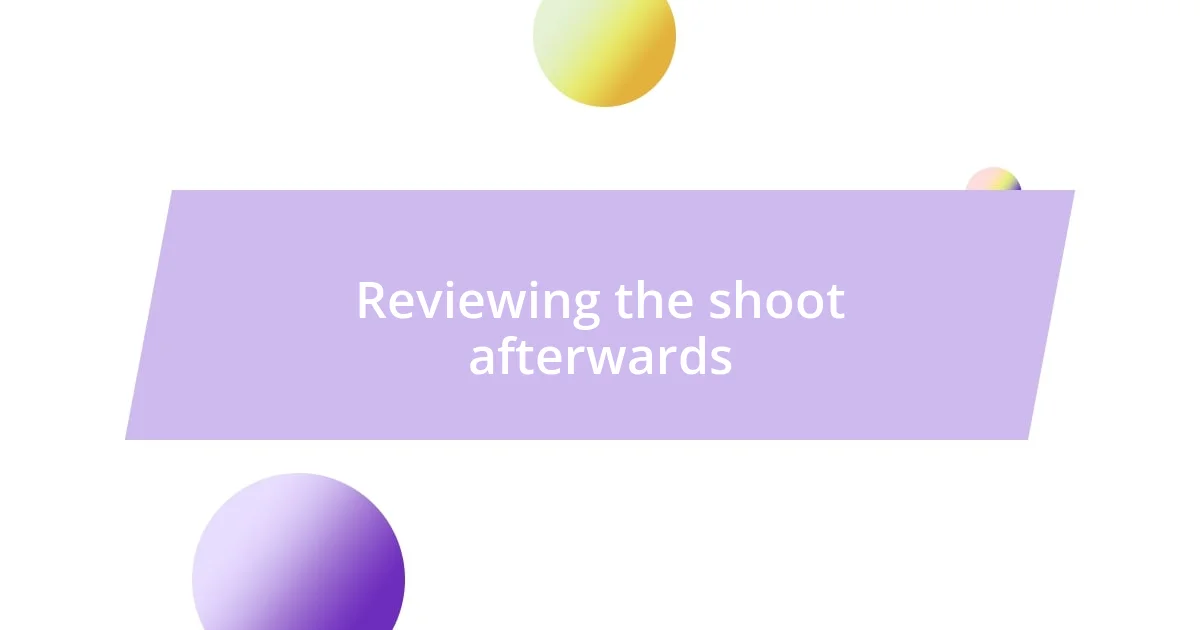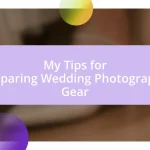Key takeaways:
- Preparation is crucial for a successful shoot, including creating a shot list, scouting locations, and ensuring all necessary equipment is ready.
- Effective communication with the photographer before and during the shoot enhances collaboration and helps align visions for the desired outcome.
- Post-shoot review is valuable for learning and growth, providing insights into what worked well and what can be improved for future sessions.

Preparation is key for shoots
When I think back to my early days in photography, I remember a shoot that ended up being a whirlwind of chaos simply because I hadn’t prepared properly. I showed up with a camera but no extra batteries, leading to a frantic hunt for power before we could even start. This was a stark reminder that failing to prepare is preparing to fail. Isn’t it wild how one small oversight can throw everything off balance?
For another project, I put in the effort to create a detailed shot list and timeline. This foresight transformed our day: everything flowed smoothly, and I wasn’t scrambling for angles or missing those precious moments. The energy during the shoot was so much lighter, allowing us to be creative instead of just reactive. Have you experienced a shoot where having a plan drastically changed the outcome? I certainly have, and it’s a game-changer.
I’ve also learned the value of location scouting in preparation. Before a recent outdoor shoot, I visited the site at different times of day to understand how the light would shift and shape the atmosphere. This preparation was enlightening, almost like discovering hidden treasures in familiar places. It made me wonder—how often do we paint ourselves into a corner by not exploring the landscape ahead? Planning, I’ve found, is not just about logistics; it sets the stage for creativity to flourish.

Understanding the equipment needed
Understanding the right equipment is crucial to any shoot. I remember a time when I brought my camera and lens, but forgot the tripod. That day turned into a challenge as I tried to stabilize my shots using whatever I could find—boxes, bags, even a railing! It was a lesson in how the proper gear supports our vision and creativity.
When prepping for a shoot, consider gathering the following items to avoid surprises:
- Camera: Ensure it’s in good condition and charged.
- Lenses: Bring a variety to capture different perspectives and styles.
- Tripod: Essential for stability, especially in lower light conditions.
- Extra Batteries: Trust me, running out of power mid-shoot is a nightmare.
- Memory Cards: Check that you have enough space; it’s better to have too many than not enough.
- Lighting Equipment: Depending on the shoot, portable lights or reflectors can enhance the setup significantly.
Having the right equipment not only prevents dilemmas but enhances the creative process. It’s amazing how a little foresight can lead to a smoother, more productive shoot.

Importance of planning the shoot
Planning the shoot is more than just making a to-do list; it plays a crucial role in the overall outcome. Reflecting on my early shoots, I remember the excitement of not having a clear vision. One time, I arrived with an open mind but found myself overwhelmed by choices. Without a plan, my creativity quickly turned into confusion. This experience taught me that having a structured outline is essential. It not only helps clarify my vision but also enhances my confidence as I approach each scene.
I can’t stress enough how the details matter. Once, I worked with a specific timeline for a wedding shoot, mapping out each part of the day. It felt like orchestrating a symphony—the music flowed beautifully, and I captured every significant moment without a hitch. By allocating time for each segment, I ensured no emotion went uncaptured. Have you ever tried this approach? It’s a game-changer in how you experience and document each moment.
The atmosphere of a shoot can dramatically change with meticulous planning. Recently, while preparing for a portrait session, I considered not just the light and background but also the vibe I wanted to create. I made mood boards to guide wardrobe choices and props, ensuring everything harmonized. When my subject arrived, we hit the ground running, generating vibrant energy that translated into stunning photos. That kind of synergy makes the effort worthwhile. It’s incredible how the creative process can flourish when we put in the preparation beforehand.
| Without Planning | With Planning |
|---|---|
| Overwhelmed by choices | Structured and clear vision |
| Capturing important moments is challenging | Timely coverage of significant moments |
| Confusion in creativity | Confident execution of ideas |

Communicating with the photographer
Effective communication with your photographer can make all the difference in the success of the shoot. Honestly, I used to think that simply showing up with ideas was enough. One time, I strolled into a session feeling excited about a theme but realized I hadn’t shared my thoughts beforehand. As we started shooting, we quickly discovered that my vision didn’t quite align with the photographer’s approach. It taught me to establish a dialogue early on, so both parties are on the same page.
I can’t emphasize the importance of having a pre-shoot discussion. During my first commercial shoot, I set aside time to meet with the photographer. We reviewed mood boards, talked about lighting, and sketched out specific shots. This back-and-forth not only clarified expectations but also sparked some creative ideas we hadn’t initially considered. Wouldn’t you agree that the more you share, the more possibilities open up? That’s exactly what happened for us!
Another crucial element is being open to feedback during the shoot. There was a time I was adamant about the look I wanted, but my photographer gently suggested we try something different. At first, I hesitated; it felt like stepping out of my comfort zone. But once we experimented with their idea, the end result was nothing short of magical. I learned that trusting each other’s expertise can elevate the shoot to new heights. Communication is a two-way street; building that rapport is essential for capturing those unforgettable moments.

Choosing the right outfits
Choosing the right outfits for a shoot is often more challenging than I initially realized. I remember a session where I packed a vibrant dress, excited about how it would pop in photos. But when I arrived, the location was more muted and earthy than I anticipated. I quickly learned that the best outfits should not only reflect your personal style but also harmonize with the environment. Have you ever experienced that mismatch? It can really impact your confidence and how you feel during the shoot.
One tip I found invaluable was coordinating colors and patterns. During a family portrait session, we opted for soft, complementary colors that beautifully blended into the autumn foliage. I noticed how the family’s attire not only felt cohesive but also added warmth to the images. The subtle mix of textures and fabrics made a significant difference in how the photos turned out. It’s fascinating how something as simple as choosing the right colors can enhance the overall vibe of your images!
Don’t forget to factor in comfort when selecting outfits. I once wore a stunning but incredibly restrictive outfit, thinking it would make me look beautiful. Instead, I felt trapped, and that discomfort reflected in my expressions. The experience taught me that being at ease in what I wear is just as important as looking good. So, ask yourself: will this outfit let me move and express myself freely? In my opinion, comfort and style should go hand in hand; your best moments often come when you feel relaxed and confident in your choices.

Tips for feeling confident
Feeling confident before and during a shoot is truly essential. One of the ways I’ve found to boost my confidence is through visualization. Before my most recent shoot, I took some time to picture how I wanted to look and feel. I closed my eyes and imagined myself radiating confidence in front of the camera. This mental rehearsal made such a difference! Have you ever tried visualizing a positive outcome? It can transform your mindset and set the stage for a successful session.
Additionally, practicing poses can alleviate some of that pre-shoot anxiety. I recall spending an afternoon in front of a mirror, experimenting with different angles and expressions. While it might feel a bit silly at first, this exercise helped me discover what worked best for my body and face. When the shoot day arrived, I felt a sense of familiarity, and it reduced the pressure of posing on the spot. Isn’t it incredible how a little preparation can help you shine?
Lastly, it’s important to remind yourself of your worth and unique beauty. I’ve had moments before shoots where self-doubt crept in, making me question my appearance. However, embracing affirmations, like “I am enough” or “I bring something special to this shoot,” has been transformative. When I say these before stepping in front of the lens, my confidence skyrockets. So, what do you tell yourself before facing the camera? In my experience, those positive affirmations can create a ripple effect, leading to photos that truly reflect your best self.

Reviewing the shoot afterwards
Reviewing the shoot afterward can be a remarkable learning experience. I remember sitting down with the images post-session, feeling a mix of excitement and anxiety. It hit me how much there is to glean from looking back; what worked, what didn’t, and how my emotions during the shoot translated to the final frames. Have you ever stopped to analyze a moment captured in time? It can reveal layers of insight that you might miss while in the moment.
As I scrolled through the gallery, I couldn’t help but notice how my mood influenced each shot. There was a photo where I felt awkward, and it showed—a tense smile that felt forced. This taught me that the energy we carry into a shoot profoundly affects the outcome. I started asking myself: How can I ensure I’m in the right headspace next time? I found that taking a moment to breathe and re-center during our sessions dramatically improved the final results.
I’ve also discovered the value of soliciting feedback from the photographer after the shoot. I once chatted with my photographer, who pointed out lighting nuances I hadn’t noticed. This conversation opened my eyes to technical aspects I could focus on for future sessions. It’s a bit like coaching; constructive criticism can pave the way for improvements in our future endeavors. So, how can we approach these discussions to make them fruitful? I find that being open to learning and exploring what didn’t work encourages growth and makes future shoots even more fulfilling.














